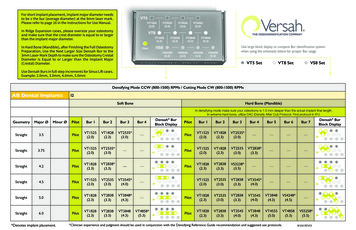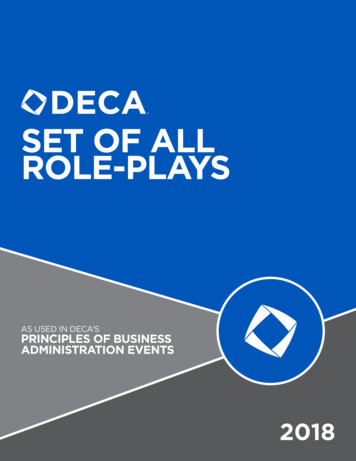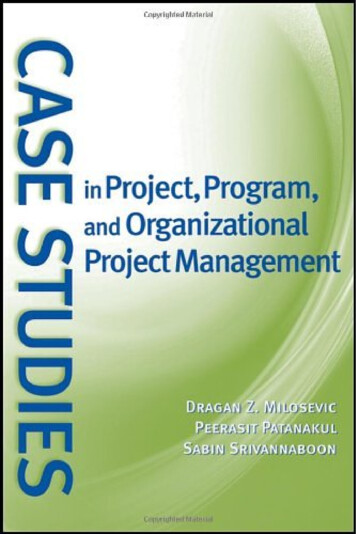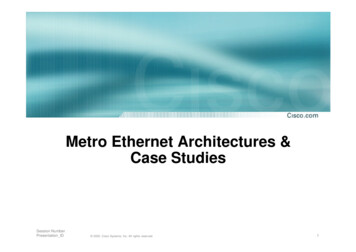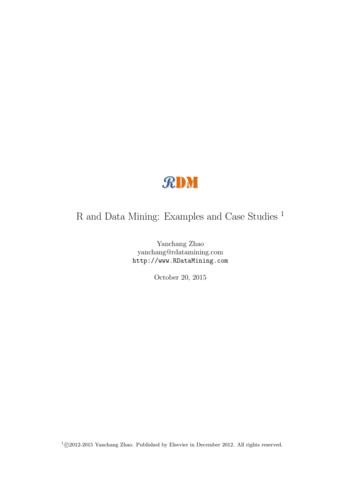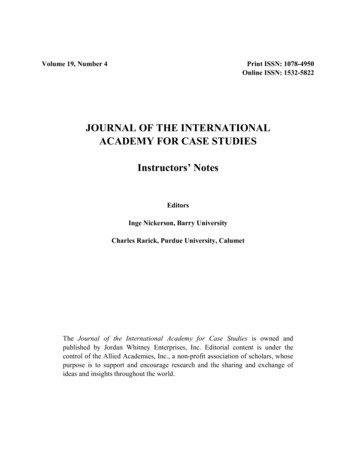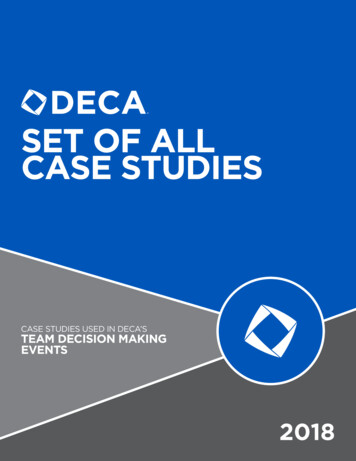
Transcription
SET OF ALLCASE STUDIESCASE STUDIES USED IN DECA’STEAM DECISION MAKINGEVENTS2018
BUSINESS LAWAND ETHICSCASE STUDIES USED IN DECA’STEAM DECISION MAKINGEVENTS2018
BUSINESS LAW ETHICS TEAMDECISION MAKING2018 CASE STUDIESINCLUDES:INTEGRATE DECA’S ROLE-PLAYS AND CASE STUDIES INTO YOUR CLASSROOMSAMPLE CASE STUDY 1: ECONOMICSSAMPLE CASE STUDY 2: EMOTIONAL INTELLIGENCESAMPLE CASE STUDY 3: MARKETINGPublished by Shop DECA. Copyright 2018 by DECA Inc., 1908 Association Drive, Reston, VA 20191.No part of this publication may be reproduced for resale without written permision from the publisher. Printed in the United States.
INTEGRATE DECA’S ROLE-PLAYS AND CASE STUDIESINTO YOUR CLASSROOMWith its connection to National Curriculum Standards, DECA’s Competitive Events Program is designed to be integrated intoclassroom instruction to help members apply learning and connect to business. As teaching tools, DECA’s role-plays and casestudies provide relevant, meaningful problems for students to solve, provide a standards-based evaluation, increase rigor of theinstruction, result in evidence of student learning and expose students to DECA – all as part of classroom instruction.STEP 1: FAMILIARIZE YOURSELF WITH EVENT GUIDELINES AND PERFORMANCE INDICATORS.Use the DECA Guide to familiarize yourself with event guidelines that explain how each competitive event will operate – timelimits, exam specifications, interactions with a judge, etc.Role-plays and case studies are developed using performance indicators – key concepts from national curriculum standardsthat students should learn during the school year. DECA uses five lists of performance indicators which are organized by careercluster – business administration core, business management and administration, finance, hospitality and tourism, and marketing,as well as personal financial literacy.Each performance indicator list is arranged by instructional areas to assist advisors with planning units of instruction. Advisorsteaching accounting courses, for example, can use the Finance Career Cluster performance indicator list to plan their curriculumwhile advisors teaching marketing courses can use the Marketing Career Cluster performance indicator list.STEP 2: UNDERSTAND HOW ROLE-PLAYS AND CASE STUDIES ARE DESIGNED.The career cluster and primary instructional area for role-plays and case studies are identified at the top of the first page of theevent.Role-plays used for DECA’s Principles of Business Administration Events measure four performance indicators from the businessadministration core.Case studies used for DECA’s Team Decision Making Events measure seven performance indicators. Usually, at least four of theseven performance indicators have been selected from the case study’s instructional area. Therefore, if the event situation isasking the participant to develop a promotion plan, most of the performance indicators will be from the promotion instructionalarea.Role-plays used for DECA’s Individual Series Events measure five performance indicators. Usually, at least three of the fiveperformance indicators have been selected from the event situation’s instructional area. The career pathway is also identified onthe role-play, which may include performance indicators from that specific pathway as well.Role-plays used for DECA’s Personal Financial Literacy event measure three performance indicators from the National Standardsin K–12 Personal Finance Education, created and maintained by the Jump tart Coalition for Personal Financial Literacy.STEP 3: START ORGANIZING SAMPLE EVENTS.Each year, DECA posts sample role-plays and case studies on deca.org. Shop DECA also sells previously used events each year.Gather these samples and begin to categorize them by instructional area.STEP 4: USE SAMPLE EVENTS AS A CLASSROOM ACTIVITY.As you teach different instructional areas during the year, use corresponding role-plays and case studies as learning tools. Whilethe traditional competitive event setting requires interaction with judges, many advisors have used role-plays and case studies as: warm-up activities at the beginning of classes. writing exercises that require students to write their ideas for solving the problem presented in the role-play or case study. public speaking exercises that require students to deliver an oral report or recorded video that presents their ideas forsolving the problem presented in the role-play or case study. assessment tools in lieu of a multiple-choice quiz/test.Since the evaluation form for each role-play and case study assesses the performance indicators, you are assessing students’performance according to national curriculum standards which are industry validated and aligned to career clusters.ADDITIONAL RESOURCESEvent guidelines, performance indicator lists, sample events and sample exam questions are available at www.deca.org/competitiveevents. Sample role-play presentations can be viewed at www.deca.org. Advisors may wish to show the videosand ask students to evaluate the presentations using the evaluation forms. Shop DECA sells many items to assist advisors withintegrating DECA into curriculum at shopdeca.org.
CAREER CLUSTERBusiness Management and AdministrationINSTRUCTIONAL AREAEconomicsBUSINESS LAW AND ETHICSTEAM DECISION MAKING EVENTPARTICIPANT INSTRUCTIONS The event will be presented to you through your reading of the 21st Century Skills, PerformanceIndicators and Case Study Situation. You will have up to 30 minutes to review this informationand prepare your presentation. You may make notes to use during your presentation. You will have up to 10 minutes to make your presentation to the judge (you may have morethan one judge), followed by up to 5 minutes to answer the judge’s questions. All members ofthe team must participate in the presentation, as well as answer the questions. Turn in all of your notes and event materials when you have completed the event.21st CENTURY SKILLS Critical Thinking – Reason effectively and use systems thinking. Problem Solving – Make judgments and decisions, and solve problems. Communication and Collaboration – Communicate clearly and show evidence ofcollaboration. Creativity and Innovation – Show evidence of creativity.PERFORMANCE INDICATORS Explain the types of economic systems.Determine factors affecting business risk.Explain the principles of supply and demand.Explain the nature of business ethics.Recognize and respond to ethical dilemmas.Explain ethical considerations in providing information.Explain information privacy, security, and confidentiality considerations in business.Published 2018 by DECA Inc. Copyright 2018 by DECA Inc. No part of this publication may be reproduced forresale or posted online without written permission from the publisher. Printed in the United States of America.
CASE STUDY SITUATIONYou are to assume the roles of marketplace director and senior vice president for ETOWN, acompany that manages ETOWN.COM, an online auction website. The CEO of the company (judge)has asked you to analyze cyberscalping claims and determine how the company should handle theaccusations and requests for information.ETOWN.COMis a popular online shopping website that provides customers the option to both buyand sell goods on its site. Users of the website must register with an email address, phone numberand physical address in order to buy or sell merchandise. Users must electronically agree to theterms of services for ETOWN prior to using the website. ETOWN promises confidentiality, keepingall user information private.To sell an item on ETOWN, the seller posts item information along with a photograph. Typically,an item is listed for three to five days on the online marketplace. The seller must identify shippingcharges, but allows interested buyers to bid on the purchase price. If the item is popular, the bidsincrease, raising the price. This process allows the seller to receive the maximum price buyers arewilling to pay for the item. ETOWN receives a percentage of all purchase prices.The company has been successful since its launch in 1995 and has had few very issues with buyersand sellers up until recently. New computer programs have been developed that are being used tomake mass online purchases. A tech-savvy person with access to the sophisticated program is ableto purchase large quantities of the same item online, completely selling out popular items. Forexample, a new gaming system was introduced this past spring. The gaming system sold out inminutes, most being sold to people using the program. In turn, those items were then being listedon ETOWN with extremely high bids. An 80.00 gaming system was sold for 13,000 on ETOWN.This process is called cyberscalping.Cyberscalping is most rampant during the holiday season. Parents are looking to purchase populartoys and stores sell out quickly. A popular dollhouse that retails for 299.00 has winning ETOWNbids of 1,700. A toddler toy that retails for 49.99 has winning ETOWN bids of over 250.00. Alldue to cyberscalpers quickly purchasing all retail inventory.In 2016, Congress passed the Better Online Ticket Sales Act which prohibits cyberscalping, butthe legislation only applies to ticket sales, not toys or other products. The legislation was passedto save consumers money and frustration.With information about cyberscalping and inflated prices of items on ETOWN surfacing, manyfrustrated parents and lawmakers are speaking out. People are upset that families are being takenadvantage of during the holiday season and cannot afford to purchase toys that are reasonablypriced in stores, due to cyberscalping.Lawmakers have now started lashing out at ETOWN. Company privacy policies keep all userinformation confidential, unless criminal activity is suspected. Since there is no current legislationthat applies to cyberscalping toys or products, ETOWN will not release user information toconsumer watchdog groups. Lawmakers feel ETOWN is acting unethically. Since ETOWN has
access to user information, they could stop cyberscalper sellers from using ETOWN to sell thescalped merchandise. Lawmakers feel ETOWN is also at fault since the company earns a percentageof the purchase price.Executives at ETOWN are unsure how to proceed. No laws are being broken. If ETOWN users arewilling to place high bids on popular items and pay increased prices that is up to the buyer. Nobodyis forcing buyers to pay exorbitant prices.The CEO of ETOWN (judge) has asked your team to analyze the situation and decide how toproceed. The CEO (judge) wants a full analysis of the following in your presentation: The economic systemSupply and demandETOWN’s confidentiality agreementsBusiness risks associated with acting or not acting to stop cyberscalpingFinal recommendation and best method for communicating ETOWN’s decisionYou will present your analysis and recommendation to the CEO (judge) in a meeting to take placein the CEO’s (judge’s) office. The CEO (judge) will begin the meeting by greeting you and askingto hear your ideas. After you have presented your analysis and recommendation and have answeredthe CEO’s (judge’s) questions, the CEO (judge) will conclude the meeting by thanking you foryour work.
JUDGE’S INSTRUCTIONSYou are to assume the role of CEO for ETOWN, a company that manages ETOWN.COM, an onlineauction website. You have asked the marketplace director and senior vice president (participantteam) to analyze cyberscalping claims and determine how the company should handle theaccusations and requests for information.ETOWN.COMis a popular online shopping website that provides customers the option to both buyand sell goods on its site. Users of the website must register with an email address, phone numberand physical address in order to buy or sell merchandise. Users must electronically agree to theterms of service for ETOWN prior to using the website. ETOWN promises confidentiality, keepingall user information private.To sell an item on ETOWN, the seller posts item information along with a photograph. Typically,an item is listed for three to five days on the online marketplace. The seller must identify shippingcharges, but allows interested buyers to bid on the purchase price. If the item is popular, the bidsincrease, raising the price. This process allows the seller to receive the maximum price buyers arewilling to pay for the item. ETOWN receives a percentage of all purchase prices.The company has been successful since its launch in 1995 and has had few very issues with buyersand sellers up until recently. New computer programs have been developed that are being used tomake mass online purchases. A tech-savvy person with access to the sophisticated program is ableto purchase large quantities of the same item online, completely selling out popular items. Forexample, a new gaming system was introduced this past spring. The gaming system sold out inminutes, most being sold to people using the program. In turn, those items were then being listedon ETOWN with extremely high bids. An 80.00 gaming system was sold for 13,000 on ETOWN.This process is called cyberscalping.Cyberscalping is most rampant during the holiday season. Parents are looking to purchase populartoys and stores sell out quickly. A popular dollhouse that retails for 299.00 has winning ETOWNbids of 1,700. A toddler toy that retails for 49.99 has winning ETOWN bids of over 250.00. Alldue to cyberscalpers quickly purchasing all retail inventory.In 2016, Congress passed the Better Online Ticket Sales Act which prohibits cyberscalping, butthe legislation only applies to ticket sales, not toys or other products. The legislation was passedto save consumers money and frustration.With information about cyberscalping and inflated prices of items on ETOWN surfacing, manyfrustrated parents and lawmakers are speaking out. People are upset that families are being takenadvantage of during the holiday season and cannot afford to purchase toys that are reasonablypriced in stores, due to cyberscalping.Lawmakers have now started lashing out at ETOWN. Company privacy policies keep all userinformation confidential, unless criminal activity is suspected. Since there is no current legislationthat applies to cyberscalping toys or products, ETOWN will not release user information toconsumer watchdog groups. Lawmakers feel ETOWN is acting unethically. Since ETOWN hasaccess to user information, they could stop cyberscalper sellers from using ETOWN to sell the
scalped merchandise. Lawmakers feel ETOWN is also at fault since the company earns a percentageof the purchase price.Executives at ETOWN are unsure how to proceed. No laws are being broken. If ETOWN users arewilling to place high bids on popular items and pay increased prices that is up to the buyer. Nobodyis forcing buyers to pay exorbitant prices.You have asked the marketplace director and senior vice president (participant team) to analyzethe situation and decide how to proceed. You want a full analysis of the following in thepresentation: The economic systemSupply and demandETOWN’s confidentiality agreementsBusiness risks associated with acting or not acting to stop cyberscalpingFinal recommendation and best method for communicating ETOWN’s decisionThe marketplace director and senior vice president (participant team) will present an analysis andrecommendation to you in a meeting to take place in your office. You will begin the meeting bygreeting the marketplace director and senior vice president (participant team) and asking to hearabout their analysis.After the marketplace director and senior vice president (participant team) have presented theanalysis and recommendation you are to ask the following questions of each participant team:1. Do you think it is important that we address cyberscalping on our website or in an email toour users?2. If the laws change and cyberscalping products becomes illegal, how can we tell thedifference between supply and demand and cyberscalping?Once the marketplace director and senior vice president (participant team) have answered yourquestions, you will conclude the meeting by thanking them for their work. You are not to makeany comments after the event is over except to thank the participants.
JUDGING THE PRESENTATIONTeam members, assuming the role of a management team for the business represented, will analyze a casesituation related to the chosen occupational area. The team will make decisions regarding the situation, andthen make an oral presentation to the judge. The role of the judge is that of an executive for the business.Participants will be evaluated according to the Evaluation Form.Please place the name and identification number label on the Scantron sheet (unless it has already beendone for you).Participants will have a 30-minute preparation period and may make notes to use during the role-play.During the first 10 minutes of the presentation (after introductions), the team will present their analysis,their decisions and the rationale behind the decisions. Allow the teams to complete this portion withoutinterruption, unless you are asked to respond.During the next 5 minutes, you may ask questions of the team to determine their understanding of thesituation presented. Each member of each team should respond to at least one question. To ensure fairness,you must ask each team the same questions. After asking the standard questions, you may ask otherquestions for clarification specific to the current team.After the questioning period, please thank the team and state that they will be notified of your decisionsoon. Then complete the Evaluation Form, making sure to record a score for all categories. The maximumscore for the evaluation is 100 points. The presentation will be weighted at twice (2 times) the value of theexam scores.A maximum score of “Exceeds Expectations” in any category means that, in your opinion, the informationis presented effectively and creatively; nothing more could be expected of an employee.A “Meets Expectations” rating means that the information is present well. Though there may be a few minorproblems or omissions, they are not significant. Creativity, however, is not shown to any great degree. Acombined total score of 70 or better on the written and presentation sections will earn the participant teamDECA’s Certificate of Excellence at the international conference.A “Below Expectations” score means that the information presented does not meet minimum standards ofacceptability.A “Little/No Value” score means either that some major flaw has been noted that damages the effectivenessof the presentation (this may be a major omission, a serious misstatement or any other major flaw) or thatthe information presented is of no value (does not help the presentation at all).We hope you are impressed by the quality of the work of these potential managers. If you have anysuggestions for improving the event, please mention them to your series director.We thank you for your help.
BUSINESS LAW AND ETHICS TEAM DECISIONMAKING, 2018JUDGE’S EVALUATION FORMParticipant:Participant:I.D. Number:INSTRUCTIONAL AREAEconomicsDid the participant 89-100-12-345-60-12-345-60-12-345-6PERFORMANCE INDICATORS1.2.3.4.5.6.7.Explain the types of economicsystems?Determine factors affecting businessrisk?Explain the principles of supply anddemand?Explain the nature of business ethics?Recognize and respond to ethicaldilemmas?Explain ethical considerations inproviding information?Explain information privacy, security,and confidentiality considerations inbusiness?21st CENTURY SKILLS8.9.10.Reason effectively and use systemsthinking?Make judgments and decisions, andsolve problems?Communicate clearly and showevidence of collabor
cluster – business administration core, business management and administration, finance, hospitality and tourism, and marketing, as well as personal financial literacy. Each performance indicator list is arranged by instructional are
